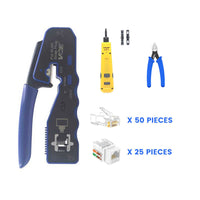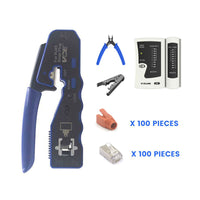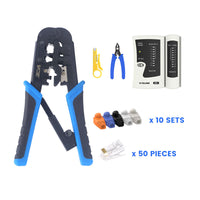Introduction
You’re excited that, finally, you have a “smart home” with numerous devices working over the network. That excitement can turn into frustration if you have a dumb WiFi. Your video doorbell starts lagging, your smart speakers keep losing connection, or your streaming box buffers constantly. These signs indicate your single router isn’t cutting it any longer. Here you have two popular solutions. The debate is: WiFi mesh vs. access points.
Accompany us throughout this guide, which will explain what each setup does, what makes them different, and how to choose the right one for your smart home.
Why Strong WiFi is Essential for Smart Homes
Smart homes depend on stable and dependable connectivity. And a single router will most likely not fully meet the demands, particularly in multi-story homes or buildings with thick walls.
According to PR Newswire, in 2023, homes had an average of 21 connected devices. On the other hand while Consumer Affairs, Journal of Consumer Research, published that as of 2022, there were about 57.55 million smart home device users, and predicted that by 2025, 57% of U.S. homes would have smart home devices. It’s clear that smart homes are no longer a fashion trend for tech fans; they are becoming the norm.
Why does this growth matter? It’s because every new gadget added competes for bandwidth. For that reason, picking between WiFi mesh vs. access points directly affects your smart home functionality and performance.
The most popular smart devices are smart TVs, speakers, and streaming devices. Yet, there are many categories of smart home devices and appliances, such as:
- Voice assistants and smart speakers
- Lighting systems that let you turn on/off lights using an app or through voice commands
- Security and monitoring gadgets like video doorbells, cameras, or smart locks
- Thermostats that control your residence’s temperature
- Garage door openers you can monitor or operate from any place
- Smart appliances such as ovens and refrigerators
Having the right internet speed is decisive for the optimal functioning of your smart home, and it should be calculated based on the number of devices. Typically, you’ll need:
- 1 or 2 devices: Up to 25 Mbps
- 3 to 5 devices: 50 to 100 Mbps
- Over 5 devices: 150 to 200 Mbps
- More smart devices, including gaming and 4K streaming: 200 to 300 Mbps
- Households with multiple devices and high usage (advanced smart homes): 500 Mbps or more
(The above bullet points and Mbps requirements for devices are rules of thumb, not strict standards)
Expert Tip: When planning your WiFi setup, consider future devices. If you have 25 today, you’ll probably have over 40 smart gadgets in a few years.
Now, let’s dig into the debate WiFi mesh vs. access points, so you can make an informed decision when deciding your networking solution.
What is WiFi Mesh?
WiFi mesh or mesh WiFi systems combine a WiFi router with one or more mesh satellites to extend the coverage reach of a WiFi network wirelessly. In a WiFi mesh setup, several devices (called nodes or satellites) work together to create a single, flawless network. Basically, you place the nodes around your house, and they pass your connection between each other automatically.
Advantages of WiFi Mesh
- Extended coverage: Through the nodes or satellites communicating with one another, you’ll have a reliable connection in all corners of your house or office.
- Seamless roaming: You don’t need to reconnect as you move around or between floors.
- Easy setup: Most systems have mobile apps to guide you.
- Self-recovery: If one node fails, traffic is automatically rerouted.
- Easy scalability: If you need to extend the WiFi coverage even more, plugging in additional nodes will suffice.
Cons of WiFi Mesh
- Higher cost than basic access points.
- The performance could dip if node-to-node communication relies only on WiFi instead of wired Ethernet.
- Not the best option for low-broadband areas: Mesh doesn’t improve poor Internet Service Provider (ISP) speeds. So, in rural or underdeveloped areas with weak broadband, its benefits will be limited.
- Eventual unnecessary investment: In smaller spaces, a mesh system won’t justify the higher cost compared to a standard router
Expert Tip: If your mesh system allows it, connect the nodes to Ethernet cables for better backhaul functioning. This will improve the reliability and speed of your mesh network.
What are Access Points (APs)?
An access point (AP) or wireless access point (WAP) is a networking device that enables connecting a wired network (like a router or switch) and wireless devices (like laptops, smartphones, cameras, etc), eliminating the need for physical cables. When a wireless device wants to connect to a network, it connects with the nearest access point. Once the access point receives the signal, it transmits it to the wired network. Basically, an AP receives data from the wired infrastructure and transmits it over WiFi, enabling wireless devices to join that network.
Advantages of Access Points
- Easy to scale: You can add more APs as needed without making important changes to your infrastructure.
- Mobility: Users can move within a building without losing their connection.
- Support heavy traffic effectively.
- Easy to manage: They require less upkeep than wired networks.
- Cost-effective: It’s cheaper to install APs than to deploy large wired networks.
Cons of Access Points
- Requires Ethernet cabling: Wiring is needed between APs and the router or switch
- Setup complexity: Setup usually requires technical knowledge
- Dependency on Internet speed: Access points depend on your Internet connection to provide stability.
- Limited reach: Compared to wired networks, access points offer flexibility but oftentimes a shorter range and less stability than Ethernet-based Internet.
Expert Tip: When installing access points, opt for Cat6 or Cat6a cabling to support Gigabit and higher speeds.
WiFi Mesh vs. Access Point: Main Differences
Here’s a table for quickly comparing WiFi mesh vs. access points:
|
Factor |
WiFi Mesh |
Access Points |
|
Coverage |
Whole-home, seamless roaming |
Strong per AP, but requires Ethernet cabling |
|
Setup |
App-based, beginner-friendly |
More complex, often requires IT knowledge |
|
Scalability |
Add nodes easily |
Add APs, but a wired pillar is needed |
|
Performance |
Great for homes, weaker under heavy loads |
Handles high traffic, better for offices |
|
Cost |
Higher upfront (complete kit) |
Cheaper per AP, but cabling adds cost |
Expert Tip: If your home doesn’t have Ethernet wires, mesh will usually be the easiest and reliable choice. If you already have cabling, go for APs, as they are more powerful and future-proof.
Choosing the Right Solution for Your Smart Home
We’ve reviewed WiFi mesh vs. access points, and maybe you’re still unsure which one to choose. The short list below will help you come up with the best decision:
Choose WiFi mesh if:
- You live in a large or multi-story home.
- You want a simple plug-and- play solution.
- You don’t have Ethernet cabling in your walls.
Choose access points if:
- You have Ethernet ports in each room.
- You want enterprise-lev el performance at home.
- You prefer to have more control over your network setup.
Hybrid setups are possible, too. Some advanced smart homes combine a mesh system for general coverage plus wired access ports for high-traffic areas like home offices, business offices, or media rooms.
Installation Tips & Best Practices
- Place mesh nodes or APs in open areas, and avoid hiding them behind cabinets or TVs.
- Keep your devices away from cordless phones, microwaves, and thick walls.
- If you opt for APs, use high-quality Ethernet cables (Cat6 or Cat6a).
- After installation, always run a speed test to verify the network performance.
- Regularly update the firmware for security and stability.
Expert Tip: Use a WiFi analyzer app to identify dead zones and to determine the optimal placement for your nodes or APs.
Troubleshooting WiFi Dead Zones
A WiFi dead zone is an area in your home where you should have connectivity, but you don’t. Spotting them is easy; you are in a dead zone when you find that some apps are not opening, or a video call disconnects.
Both mesh WiFi and access points can result in dead zones.
With WiFi mesh, this can happen due to:
- Incorrect node placement
- Excess of nodes
- Wireless backhaul problems (when mesh nodes rely on wireless connections for connecting back to the main router).
With access points, dead zones can occur because of:
- Incorrect access points placement
- Limited coverage area (each access point has a limited signal range).
- Insufficient number of access points.
Despite your networking system, if you find dead zones, before panicking and calling a technician, try these easy troubleshooting steps:
- Restart your mesh system or router.
- Check if your firmware is updated.
- Reposition the nodes or APs so as to ensure you’re avoiding any interferences.
- Run diagnostic with built-in system tools.
- For APs, check if Ethernet runs are intact and test them with a cable tester.
Conclusion
When it comes to the debate WiFi Mesh vs. Access Points, there’s no one-size-fits-all fix.
Mesh WiFi offers simplicity and whole coverage for households without Ethernet cabling. Access points, on the other hand, give you enterprise-grade dependability if you already have a wiring setup.
Your choice between the two systems depends on your home’s size, wiring, and the number of devices you need to connect. Regardless of your decision, upgrading from a single-router setup will translate into smoother streaming, smarter automation, and fewer disappointments.
Key Takeaways: WiFi Mesh vs. Access Points
WiFi Mesh: The best option for large or multi-story homes or businesses without Ethernet cabling. It’s easy to set up, offers seamless roaming, but is more expensive.
Access Points (APs): Are the ideal option for homes that have Ethernet wiring. They are cheaper, support heavy traffic, but require a more complex setup.
Key Difference: Mesh utilizes wireless nodes to cover your home, and APs extend the coverage through wired connections.
Choosing Tip:
-Select mesh if you want simple plug-and-play WiFi.
-Select APs if you want maximum performance and already have wired connections.
Expert Tip: Don’t overlook hybrid setups. That is, using a mesh system for general coverage plus APs for high-demand rooms or areas.



Geben Sie als Erster einen Kommentar ab.
Hinterlasse einen Kommentar